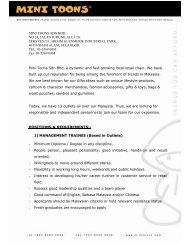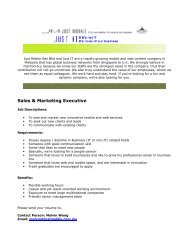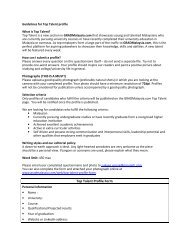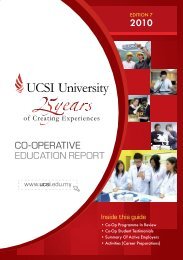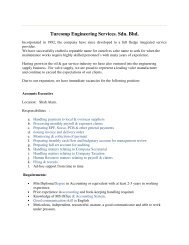MP491/6-Undergraduate Research Project Proposal 1. Title ... - UCSI
MP491/6-Undergraduate Research Project Proposal 1. Title ... - UCSI
MP491/6-Undergraduate Research Project Proposal 1. Title ... - UCSI
Create successful ePaper yourself
Turn your PDF publications into a flip-book with our unique Google optimized e-Paper software.
6. <strong>Title</strong>: Evaluation of hypoglycemic activity of Limonia acidissima bark extract.<br />
Supervisor(s)<br />
Main: Mr. Nalamolu Koteswara Rao.<br />
Co- : Dr. Gabriel Akowuah.<br />
Objective(s)<br />
<strong>1.</strong> Evaluation of hypoglycemic activity of Limonia acidissima bark extract using<br />
streptozotocin-induced diabetic rats.<br />
Abstract<br />
Diabetes mellitus is an endocrine disorder that is characterized by hyperglycemia and<br />
a number of complications such as nephropathy, retinopathy, neuropathy, and<br />
cardiopathy. A worldwide survey showed that nearly 10% of the population is affected by<br />
this disorder. Modern treatment of diabetes based on oral hypoglycaemics<br />
(sulphonylureas, biguanides and –glucosidase inhibitors) and insulin showed an<br />
adverse effect with relatively high rates of secondary failure. As an alternative approach,<br />
scientific investigation on traditional remedies has led to the discovery of herbal drugs for<br />
the treatment of diabetes mellitus. An estimated 90% of the population in rural areas of<br />
developing countries still relies on traditional medicines for their primary health care.<br />
Limonia acidissima (Rutaceae), commonly known as wood apple (locally named<br />
belinggai), is distributed in dry warm regions of Burma, India, Malaya and Sri Lanka.<br />
Traditionally, the constituents (in paste form) from the bark of L. acidissima is mixed with<br />
water and applied mainly to the face for removal of small spots or lesions for a smooth,<br />
fair and well-textured complexion. It is also known to protect against skin cancer by<br />
blocking UV rays. Oil and constituents derived from the leaf, bark, root and fruit pulp are<br />
used against snake bites, and as fungicides, bactericides and insecticides.<br />
As constituents of bark extract from this plant have been used in traditional medicine<br />
for diabetes management, we are interested to find out the value of its hypoglycemic<br />
activity. Therefore, the evaluation of hypoglycemic activity of bark extract of L.<br />
acidissima will be useful in illustrating its mechanism of action and promote its<br />
commercial development.<br />
7. <strong>Title</strong>: Patient-Focused Medication Adherence Type-II Diabetes Mellitus<br />
Supervisor(s)<br />
Main: Assoc. Prof. Dr. Yeong Siew Wei<br />
Co- : None<br />
Objectives:<br />
<strong>1.</strong> To evaluate the effectiveness of a patient-focused tool in improving medication adherence<br />
among Type-II diabetic patients.<br />
2. To develop a patient Medication Adherence Plan (MAP) for improving medication adherence in<br />
diabetes mellitus.<br />
4






